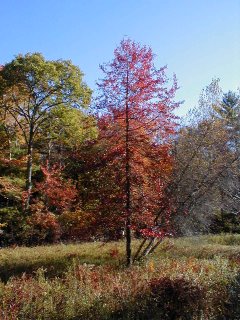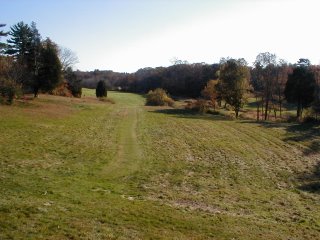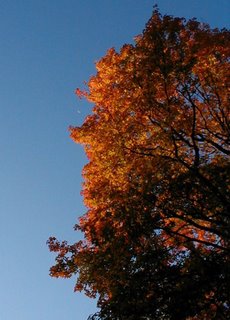
I made a promise to myself, and this time I kept it. An alternative title for this post could be “The Gums of October.”
Back in July, I spent a morning in what has become one of my very favorite Moose Hill spots, the first field along the Billings Loop from Moose Hill Street (See “And the Living is Easy,” July 1, 2006.). At the time, I was admiring a lovely tupelo gum growing in the middle of the field with its glossy dark green leathery leaves and its not-yet-ripe fruit. I promised to visit in the fall when the leaves burst forth in their scarlet autumnal display. Today was the day.
The first frost of the season was predicted for this morning so I was in no particular rush to get out of bed. I made a willful decision to play hooky from some other things I could have been doing today, knowing that any possible spiritual benefits to be found would be greater in the woods. By the time I woke up, had my first cup of coffee, packed and got on the bike it was 9:30. The weather was so wonderfully bright, dry, clear and cloudless that my concerns about being cold were baseless and I began to think that I should have started earlier to better enjoy the early light. It was one of those days when everything seems clear.
I was planning a quiet breakfast in my favorite meadow, but upon my arrival I was greeted with a riot of activity. As I approached the field I heard and then saw scores of robins clucking, chuckling and cackling excitedly as they flew back and forth from the woods to the scattered trees in the meadow. It seems most were attracted here by the same tree that brought me. There are a few black gums in this field, and most were practically leafless, but the one I was coming to see still wore its rich orangeish-red coat as if it was clinging to its leaves while waiting for my return. The robins were gorging on its bounty of ripe, juicy, dark purplish-blue, sour-sweet fruits.
Other migrants seemed to be caught up in the excitement. Yellow-rumped myrtle warblers flitted about the trees along the edge of the field and white-throat sparrows in the brushy tangles seemed unimpressed by my poorly-whistled lispy imitation of their “poor Sam Peabody” song.
Even some non-migrating locals seemed to be feeling the buzz. Chickadees, titmice and a nice red-bellied woodpecker were working the transition between field and forest.
Chipmunks were scampering along the old stone walls and gray squirrels were working the leaves under the oaks. Both were celebrating the steady thwack of heavy acorns hitting the ground.
A lone monarch was drifting over the goldenrod. I wondered if its tardiness would lead to an icy death while its cousins were sipping margaritas in Mexico. A solitary big dragonfly flew an aggressive patrol in the air above the frost-tinged ferns of the old field.
I was on sensory overload. There was so much activity and so much beauty that it was nearly an hour before I could settle down in my favorite spot in the sun for breakfast. This is a small field, but it is magical. It is bordered by old gravel roads and stone walls. There is a swamp at one end and hardwood forest around the rest. With its scattered trees, bird boxes, bee hives and brushy edges there is always something to see while sitting in my choice of sunny or shady spots. The maples were yellow and red. The elms were yellow. The white pines wore cuffs of yellow where their inner needles were turning. All these colors were nicely set off by the oaks that were still mostly deep green. There was a new flurry of falling leaves with every gust of the dry breeze. I wanted to freeze the moment in time.
After breakfast, I wandered up the dirt road to the old barn. I thanked the old long-gone farmer that shaped this land. This old farm may be reverting to a wild state, but it is by no means wilderness. The hand of man is visible everywhere, but it was work on a human scale, not the scale demanded by big machines and big money. Maybe that’s why the farm failed in the first place, but its present value to wild creatures and over-civilized suburbanites is, as they say, priceless.
It’s been a good half-year since I started these visits in April and promised myself I would explore these woods and explore my own mind. I walked by the tattered remains of the verio nest I discovered in a birch tree back in May. I saw the field where my son and I saw fireflies flashing after our summer solstice run. I thought about the frogs and peepers that welcomed me to this place on that first visit in April. I’ve lived practically in the shadow of Moose Hill for 20 years, but I’ve been paying close attention for only a few months. Already, I feel the relationship deepening.
As I walked back down the road, I saw a father sitting in the sun, sharing an apple with his two young daughters. One of the little girls was wearing a pair of toy binoculars around her neck. I recalled fondly walks in the country as a very young boy with my father. I promised myself to be true to those old memories and hoped that little girl would grow into a fine woman with a deep love for nature as she remembered this wonderful day.
By the time I got back to the field and sat down to finish my coffee and eat my own apple I was overwhelmed with emotion. Can the simple beauty of nature bring tears to the eyes? Or is it beauty combined with memories recalled, promises kept and promises broken. A bumblebee landed on my hand. I wondered if she was from the same hive as the stumbling drunkard I had watched in July. Had she come to say goodbye as the season was ending, or was she reminding me that another chapter was coming to a close? She flew away and I prepared to head home.
On the way out of the woods, I passed a sassafras tree (Sassafras albidum), its mitten-shaped leaves now yellow, and I remembered teaching my son how to make tea by boiling the roots. Thinking of my boyhood and those little girls, I wished I had spent more time with my own kids in these forests and fields 15 or 20 years ago. I hope they will remember the little time we did spend together. Perhaps I was too busy trying to figure out what I was going to be while forgetting who I already was. I felt better as I coasted rapidly down the hill on my bicycle through the crisp October air. My spirit was buoyed by a hope that it isn’t too late to start remembering who I am and by a promise to return to Moose Hill to prod those memories.




